On
her wedding day the bride is considered to be the personification of
the Goddess of fortune and beauty, Lakshmi. The
wedding day is also believed to celebrate the divinity and beauty of
the bride as she transits to womanhood. Each adornment is meant to
bring out the natural beauty of the bride. Indian weddings are not one day ceremony, it can be a week long celebration.
Mehendi Ceremony:
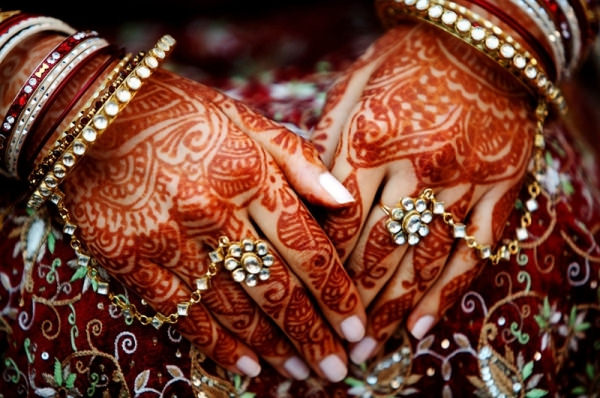 |
| Photo by Parekh Cards |
Mehendi
ceremony is a Indian tradition dating back over 9000 years ago.
Mehendi is a form of temporary body art in which decorative designs
are created on the skin, using a paste made of dried henna leaves.
The henna plant contains a reddish die that safely stains the skin.
It is essential part of wedding celebrations and many Hindu
festivals.
Mehendi
ceremony is held two or three days before the wedding. It is an
evening event which are allowed to attend only the bride, female
relatives of both sides and bride's female friends. This ceremony is
equally important as the main marriage ceremony.
 |
| Photo by Meghut Gorai |
The
henna for the bride's ceremony has to be delivered by the groom's
family on a silver tray with two burning candles. The dried leaves of
henna are crushed into a fine powder and mixed with water, lemon
juice, eucalyptus oil and clove oil until a smooth and creamy paste
is obtained.
A
professional mehendi artist or female relative that is already
happily married will apply mehendi in elaborate decorative designs to
bride's hands and feet. Designs are applied with a cone filled with
henna paste or with basic stick. Styles of mehendi design are meant
to symbolize blessings, fertility, luck, prosperity and deep bond
between husband and wife.
It
takes between 3 to 8 hours to complete the application of mehendi.
After that the bride must wait for the mehendi to dry and stain her
skin. The longer the paste stays on the skin, the darker the design
will become.
When the paste dries it will flake off revealing an orange stain. The stain darkens through oxidation after 2 or 3 days. The final color is usually reddish brown. The palms and soles stain the darkest because the skin is the thickest in these areas.
The stain can vary from pale orange to dark brow depending on the quality of the henna. Traditionally it is thought that the darker the color the mehendi leaves on the bride's hands the more she will be loved and appreciated by her husband and in-laws. To allow the color to be fully absorbed by the skin, the bride must wait at least 10 hours to wash her hands and feet.
When the paste dries it will flake off revealing an orange stain. The stain darkens through oxidation after 2 or 3 days. The final color is usually reddish brown. The palms and soles stain the darkest because the skin is the thickest in these areas.
The stain can vary from pale orange to dark brow depending on the quality of the henna. Traditionally it is thought that the darker the color the mehendi leaves on the bride's hands the more she will be loved and appreciated by her husband and in-laws. To allow the color to be fully absorbed by the skin, the bride must wait at least 10 hours to wash her hands and feet.
The
design will fade away after 2 to 4 weeks. During that time the bride
is spared from doing any housework. The longer the mehendi retains
its color, the more auspicious it is for the couple.
It is customary to hide groom's name or initials in the mehendi design. After the wedding ceremony, he has to search his name written on the bride's painted hands. The first wedding night cannot begin until he finds it.
It is customary to hide groom's name or initials in the mehendi design. After the wedding ceremony, he has to search his name written on the bride's painted hands. The first wedding night cannot begin until he finds it.
Female
relatives also get mehendi decorations applied to their hands and
feet, but in more simple designs.
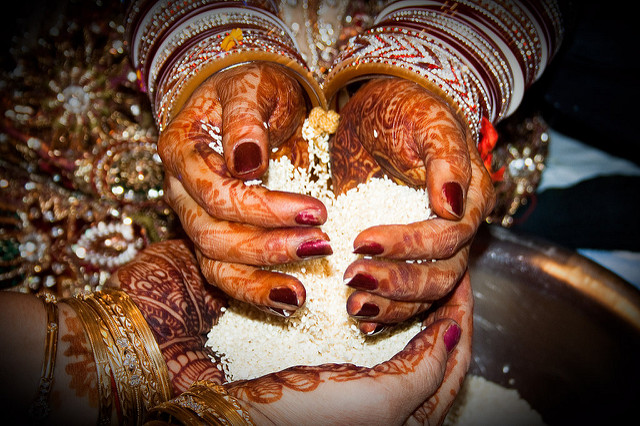 |
| Photo by Pranav Bhasin |
In
India henna has been used for medicinal and cosmetic purposes for
many thousands of years. It is still used as a natural dye for hair,
skin and fingernails as well as fabrics.
In
Ayurveda it is most commonly used for treating skin rashes,
allergies, skin inflammations, cuts, burns, bruises, and scalp
disorders. It is also used for hair care and restoring the natural pH
balance of the skin.
The
reason henna is applied on hands and feet is because according to
Ayurvedic anatomy soles and palms contain many vital points and nerve
endings that are connected to the brain and other parts of body.
It has cooling properties that soothes the nerves and the body. It prevents the nerves from tensing up and calms the mind.
The smell of henna is a powerful aphrodisiac. It has natural antiseptic, anti-fungal, anti-irritant and antibacterial properties and enhances general health. It protects the body from any viral diseases and prevents headaches and fever.
It has cooling properties that soothes the nerves and the body. It prevents the nerves from tensing up and calms the mind.
The smell of henna is a powerful aphrodisiac. It has natural antiseptic, anti-fungal, anti-irritant and antibacterial properties and enhances general health. It protects the body from any viral diseases and prevents headaches and fever.
Mehendi
decorations became fashionable in the West 20 years ago, where they
are called henna tattoos.
As it was mentioned in this article, henna naturally has orange, red or brown color depending on quality of the leaves. Due to the desire for a “tattoo-black” appearance, the synthetic dye p-Phenylenediamine (PPD) is added to henna to give it a black color. PPD can cause severe allergic reactions and permanent scars on the skin.
As it was mentioned in this article, henna naturally has orange, red or brown color depending on quality of the leaves. Due to the desire for a “tattoo-black” appearance, the synthetic dye p-Phenylenediamine (PPD) is added to henna to give it a black color. PPD can cause severe allergic reactions and permanent scars on the skin.
Haldi Ceremony:
 |
| Photo by OOTUM Design |
Haldi
ceremony is an auspicious pre-wedding ritual performed for good luck
and purification.
This
vibrant ceremony is held at both the bride and the groom's place
separately on the morning of the wedding day or one day before the
wedding.
A
paste made of turmeric, sandalwood, curd and rose water is put on a
decorated tray and taken to the priest who blesses it. Then it is
applied on the bride and groom's face, neck, arms and legs by their
relatives and dear ones. Only the married women apply the paste to
bride/groom.
The ceremony is accompanied by traditional songs and dances. This ceremony was celebrated even in Lord Shiva's wedding with Goddess Parvati.
The ceremony is accompanied by traditional songs and dances. This ceremony was celebrated even in Lord Shiva's wedding with Goddess Parvati.
As
well as mehendi, turmeric is described in earliest Vedic ritual
books.
Turmeric
has many healing and beautification properties. It provides golden
glow of the skin, brightens and evens the skin tone and prevents
premature aging.
It helps to exfoliate dead cells and detoxifies the skin. It is mild antidepressant and helps to calm an upset person. It prevents acne and ensures the bride and the groom look fresh during the wedding ceremony.
It helps to exfoliate dead cells and detoxifies the skin. It is mild antidepressant and helps to calm an upset person. It prevents acne and ensures the bride and the groom look fresh during the wedding ceremony.
It
is believed that the turmeric paste will bring prosperity to the
couple, protect them from negative energies and purifies their bodies
and soul. It has the power to ward off negative energies. It is
symbolic representation of awakening the inner light.
For
this ceremony the bride and the groom wear traditional and usually
yellow clothes to invite joy and prosperity in their life. The color
yellow is also associated with purity, new beginnings and happiness.
The
turmeric paste is washed off after setting for 3 hours, and after the
bride and the groom are blessed by elders.
There
is a belief that if the bride or the groom apply some of the turmeric
paste on their unmarried siblings or friends, it increases
possibility for them to get married in a short time.
Hairstyle:
 |
| Photo by Manjeet Singh Yadav |
On
the wedding day the bride's hair is oiled with essential oils and
then washed with mixture of water, soapnut, amla and milk.
After drying hair is scented with the aid of incense sticks and tied in a elegant bun or in a long braid. The bun is decorated with white scented flowers like jasmine, roses and bel.
After drying hair is scented with the aid of incense sticks and tied in a elegant bun or in a long braid. The bun is decorated with white scented flowers like jasmine, roses and bel.
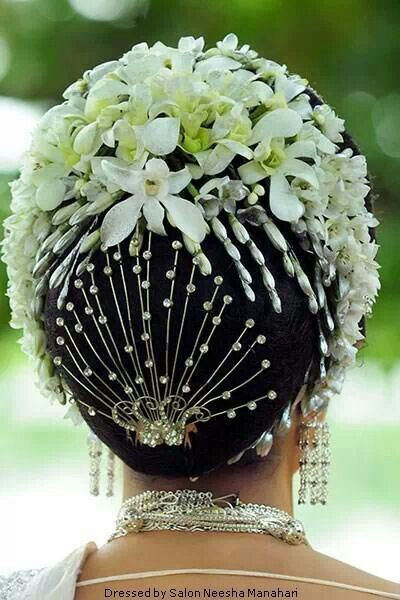 |
| Photo by Parekh Cards |
Dress:
 |
| Photo by Jean-Pierre Dalbera |
Unlike
western wedding ceremonies, brides avoid wearing white, as it’s a
symbol of mourning. Instead, they opt for a colorful dress that
reflects their region of origin. Typically, red is the most
auspicious color as it represents happiness and good luck to the
married couple. The bride is then draped with an extravagant head
scarf and a large amount of jewelry.
Eyeliner:
Kajal
or the ancient Ayurvedic black eyeliner is
applied to line both the upper and lower eyelash lines. It makes the
eyes look more enticing, by giving it a defining shape.
Earlier,
Kajal was prepared by collecting the soot of an earthen lamp by
lighting a wick in ghee and mixed with sandalwood and castor oil.
Kajal
protects eyes from, dust, sun rays and smoke. It also removes excess
impurities from the eyes.
Sindoor:
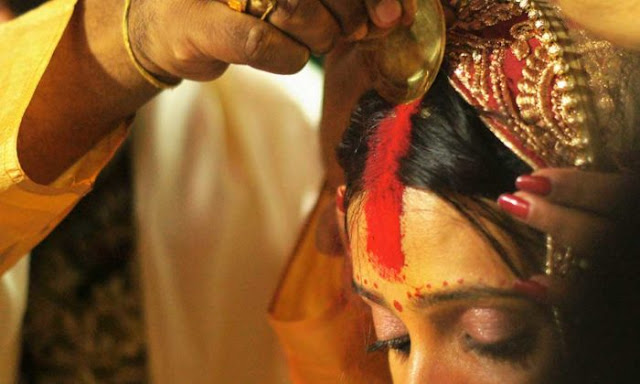 |
| Photo by Wikimedia Commons |
Sindoor
is a red cosmetic powder, applied in the parting of the hair of
married Hindu women. Traditional sindoor is made of turmeric, lime
and other herbal ingredients. The lime changes the color of turmeric
to red.
Application of sindoor has been performed for over 6000 years. It is much more than a cosmetic mark that enhances beauty.
Application of sindoor has been performed for over 6000 years. It is much more than a cosmetic mark that enhances beauty.
The
sindoor is a symbol of married woman. It is applied to the woman's
head by her husband on the day of their wedding after taking sacred
vows. After this she applies it herself every day.
It symbolizes joy and auspiciousness that bride brings with her in the new house when she is married. In Hindu traditions the bride is assumed to be one of the form of Lakshmi during marriage. Lakshmi is Hindu Goddess of wealth, prosperity and beauty and the married woman is the goddess of one home.
When other men see sindoor they are expected to treat that woman with respect.
It symbolizes joy and auspiciousness that bride brings with her in the new house when she is married. In Hindu traditions the bride is assumed to be one of the form of Lakshmi during marriage. Lakshmi is Hindu Goddess of wealth, prosperity and beauty and the married woman is the goddess of one home.
When other men see sindoor they are expected to treat that woman with respect.
Sindoor
activates crown chakra which attracts cosmic and pranic energy. It
keeps the head cool and improves concentration. On the top of
forehead is located important vital point which strengthens the
reproductive system, protects women from venereal diseases and
enhances the sexual drive.
Since
Indian women usually part their hair, sindoor acts like sunscreen and
blocks reflecting sun rays on exposed scalp.
The
color red signifies honor, power, love and prosperity. Red is known
to help retain positive energy of the body and it is believed that it
has the capability to keep you strong, healthy and positive
throughout the day.
Sindoor became poisonous only in recent times. Modern sindoor mainly uses vermilion – the purified and powdered form of cinnabar which is the chief form in which mercury sulfide naturally occurs. Red lead (lead tetroxide) is sometimes added to sindoor. It is toxic and carcinogen ingredient.
Traditional sindoor made with turmeric, lime and other herbs is not poisonous.
Traditional sindoor made with turmeric, lime and other herbs is not poisonous.
Bindi:
Bindi
is a colored dot worn on the center of the forehead, the point where
the major nerves of the body meet. When this spot is stimulated it
gives many spiritual and health benefits to person. The massage of
this point has been used in many Ayurvedic treatments.
Bindi
is applied on Ajna chakra, also known as third eye. It signifies
subconscious mind and channel trough which mental power and
spirituality can be enhanced. It is seat of wisdom and concentration.
Ayurveda and Yoga classify this region as the one spot that
facilitates the release of latent energy, also known as kundalini, as
it rises from the base of the back to the top of the head. It helps a
person become more aware, calm and focused.
The
pineal gland is the physical concomitant of Ajna chakra. The primary
function of the pineal gland is to produce melatonin. Melatonin has
various functions in the central nervous system, the most important
of which is to help modulate sleep patterns and it gives clarity on
an intuitive level.
In
Rig Veda (the earliest known text in the world) bindi is considered
the point at which creation begins and it is described as the sacred
symbol of the Cosmos in its unmanifested state.
The
bindi is said to retain energy and strengthen concentration. It is
the site where one finally loses ego when one reaches a higher level
of spirituality.
Whenever
Hindus see bindi on another people it reminds them about spiritual
activities and purpose of life. It is a way to remind one another in
the society to loo at the world through the eyes of concealed wisdom.
Traditionally
bindi is made of turmeric, saffron, sandalwood and other herbal
ingredients. Mixture of turmeric and sandalwood powder is one of the
best remedies for a headache. It relaxes the nerves and muscles of
the forehead and provides instant relief. Sandalwood is known for its
cooling properties. It helps in keeping the mind calm and cooling the
entire system.
In Ayurveda, medical herbs are heated until they turn black then made into a paste and applied to the forehead.
In Ayurveda, medical herbs are heated until they turn black then made into a paste and applied to the forehead.
For
wedding day the bindi is elaborated further with addition of dots and
vine motifs along with the eyebrows.
Today
bindi is no longer restricted in color or shape. Self adhesive bindis
are available in various metals, usually made of thin metal and
adhesive on the other side.
Modern bindis don't have any health nor spiritual benefits in any way, but is more of accessory.
Modern bindis don't have any health nor spiritual benefits in any way, but is more of accessory.
Mangalsutra:
 |
| Photo by Parekh Cards |
Indian
brides wear more than one necklace on their wedding day. One of them
is manglasutra. Mangalsutra is a black and gold beaded wedding
necklace with a gold or diamond pendant.
During
the wedding ceremony, the priest chants mantras while the groom ties
mangalsutra around bride's neck. It is believed that sacred marriage
vows are imbibed in this necklace and it signifies they are united
and binds their lives together. It is worn by the bride until her
husband's death as a sign of their love and commitment to each other.
The
beads represent the power of five great elements.
The
center of mangalsutra is placed directly over woman's Anahata or
heart chakra. Anahata chakra is associated with balance, calmness,
serenity, love and compassion. It helps in the dissolution of a
woman's negative emotions. On the physical level it helps in proper
functioning of the heart and thymus.
The
black beads absorb negative vibrations.
The
shape and size of mangalsutra may vary from region to
region.
Anklets:
 |
| Photo by Parekh Cards |
Anklets
or payals are made of silver as wearing gold on your feet is
considered inauspicious. Gold is metal of Gods and is sacred. To wear
it on the feet, the lowest part of the body, is considered to be
disrespectful and an ill omen.
Heavily
designed anklets are very important part of bride's ornaments.
Traditionally
the new bride announces her arrival in her husband's house with the
tinkling sound of anklets.
It sound also served the purpose to scare snakes when walking at night.
It sound also served the purpose to scare snakes when walking at night.
When
you wear silver anklets you are facilitating ion exchange
supplementing the body with this compound which boosts the immune
system. The energy produced while we walk is re-vibrated back to
one's body due to contact with a metal. Silver absorbs the energy
from the polar energies from the earth and passes it to the body and
refreshes whole system. It regulates the flow of life force and helps
maintain health.
The
foot is considered to be a body part that attracts a lot of filth and
dirt because people used to walk barefoot. Silver is widely known for
its anti bacterial properties. Wearing the anklets made of pure
silver stops the inflammation of foot soles.
Toe Rings:
 |
| Photo by Wikimedia Commons |
Toe
rings worn on the second toes are symbols of marriage for Hindu men
and women.
All
the paths of vital force Prana run down to the toes. The nerve
endings connected to the female reproductive system end in the second
toe. The slight pressure and friction on the second toe ensures a
healthy uterus and increases the chance of conception.
It can help the woman in bearing children and minimize risks in pregnancy. In some Ayurvedic treatments gynecological problems are treated by massaging the second toe.
It can help the woman in bearing children and minimize risks in pregnancy. In some Ayurvedic treatments gynecological problems are treated by massaging the second toe.
Usually,
toe rings are gifted by mother-in-law to bride.
The
husband puts the toe rings on his wife's second toe on both feet,
during the wedding ceremony.
Men
wear toe rings with simpler designs. Like anklets, toe rings are also
made of silver, for the same reason.
Waist chains:
Waist
chain activates Muladhara chakra and gives relief from backache.
Muladhara
is considered the foundation of the "energy body".
It emphasizes slenderness of woman's waist and improves her figure.
The slim waist of older women, even after several childbirths, is believed to be the result of the use of this ornament.
It emphasizes slenderness of woman's waist and improves her figure.
The slim waist of older women, even after several childbirths, is believed to be the result of the use of this ornament.
Earrings:
Karna
Vedha is the practice of the piercing of the ears and it is one of
the important Hindu spiritual ceremonies performed for a children.
Piercing
the ears helps in the development of intellect, power of thinking and
decision making.
For
a girl child the first ear pierced is the left ear and for a boy
child the first ear pierced is the right ear.
Ear
piercing is supposed to be one of the 16 sanskaras or rituals done to
mark various stages of human life such as education, marriage,
pregnancy, childbirth, death etc.
Piercing
has to be done exactly in the middle of the ear lobe, since there is
located an important vital point. Vital points or marmas are
described and explained in Sushruta Samhita - ancient Ayurvedic text
on medicine and surgery. Marmas are very similar to acupuncture
points.
Yogis
often stretch the piercing to stimulate psychic nerves connected to
ears.
It
improves the health of intestines.
Nose Rings:
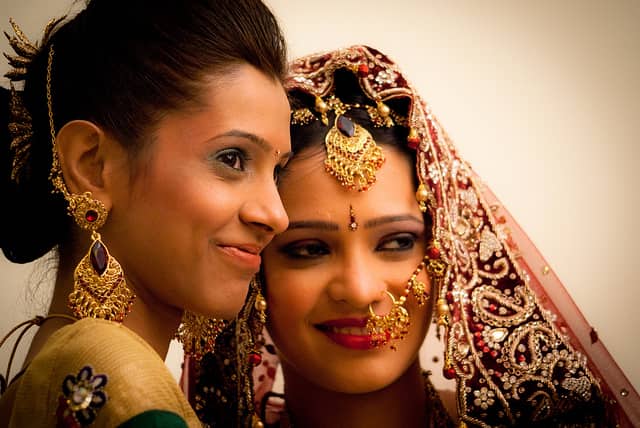 |
| Photo by Mrugesh Karnik |
Nose
piercing is one way Hindus honor Parvati – the goddess of marriage.
A girl's nose is pierced when she hits the puberty. Piercing on the left nostril is favored in Ayurveda. Ayurvedic medicine associates left side of the body with female energy. According to most authoritative Ayurvedic script Sushruta Samhita, the piercing of the nose near particular point on the left nostril lessens the amount of menstrual pain, enhance fertility and make childbirth easier.
A girl's nose is pierced when she hits the puberty. Piercing on the left nostril is favored in Ayurveda. Ayurvedic medicine associates left side of the body with female energy. According to most authoritative Ayurvedic script Sushruta Samhita, the piercing of the nose near particular point on the left nostril lessens the amount of menstrual pain, enhance fertility and make childbirth easier.
Some
women get both sides of their nose pierced and septum.
Nose
studs are usually made of gold, pearls or diamonds. Big nose hoop
joined to the ear by a chain traditionally represents a bride's
virginity.
Bangles:
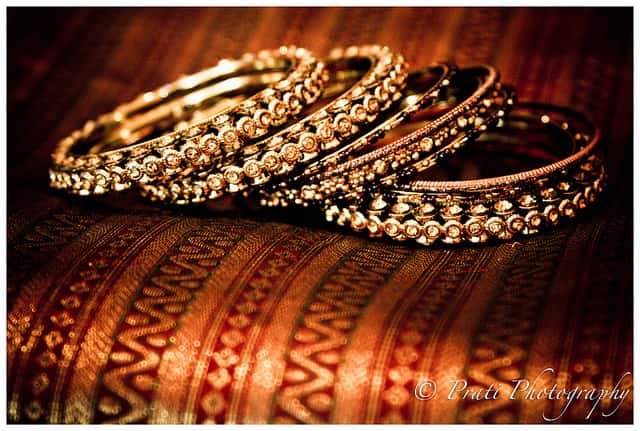 |
| Photo by Prati Photography |
According
to tradition, a woman is not supposed to buy the bangles she will
wear. Different colored bangles traditionally signify different
things. Red color symbolizes love, power and purity, blue – wisdom,
green – new beginnings, yellow – happiness, orange –
spirituality, silver – strength and gold – fortune.
They
can be made of glass, wood, ivory, precious gem stones, plastic and
metals such as gold, silver, platinum, copper and bronze. The
sound produced by bangles and other ornaments is generally a positive
vibration.
Bangles
are usually worn in pairs.
They
strengthen the heart and help regulate blood pressure.
While
the woman does her chores while wearing these bangles, the created
friction between the skin and bangles helps to improve circulation
and revitalizing her organs by pressing several vital points. It
increases circulation and channelize the energy passing through her
skin. The
more the friction, the more is the effect.
They
are also worn as a wish for the husband's long life. Indian men wear
a single bangle after wedding.
Other Jewelry:
Maang
Tikka is a hair jewelry made of gold and gems that is placed on the
bride's hairline with a pendant that sits on her forehead. This
ornament highlights the brides face.
Rings
made of different gems and metals have their own characteristics
effects on the body. They are used in controlling a number of
diseases.
Armlet
worn on the upper arm by a bride is believed to ward off evil eye.
Indian ornaments are old as Indian civilization itself. Without jewelry, the traditional dress-up of Indian men and women is incomplete.
Apart from increasing beauty, jewelry also provide financial security to women who sold it in times of need. Having a good collection of jewelry symbolizes power, good status and wealth of the owner.
Metal ornaments are highly energized and give positive energy to user. They also add to the beauty of a woman. Gold has several medical benefits. It relaxes the body and has anti-inflammatory properties. It regulates blood circulation and maintains blood pressure and attracts the positive radiations on your surroundings.
 |
| Photo by Parekh Cards |
Some
Western people consider anklets and bangles as symbol of oppression.
These were the symbol of prosperity and it added to the charm of a
person. In past times men also wore all ornaments which women wear these
days. With time these ornaments were discarded by men.
Post British annexation, the men fashioned themselves after Victorian/puritanical models of dressing. Even today in India a heavily covered in ornament woman symbolizes a wealthy family.
Author: Ayurveda Tutorials
References:
http://todaysbride.com/blog/bridal-attire-accessories/2017/07/27/bridal-attire-traditional-indian-wedding/
https://www.culturalindia.net/weddings/wedding-traditions/solah-shringar.html
https://en.wikipedia.org/wiki/Pottu_(decoration)
https://en.wikipedia.org/wiki/Sindoor
Related articles:
Make Your Own Ayurvedic Scrub
Onion Juice For Hair Growth
Ayurvedic Tips For A Healthy Menstrual Cycle
Post British annexation, the men fashioned themselves after Victorian/puritanical models of dressing. Even today in India a heavily covered in ornament woman symbolizes a wealthy family.
Author: Ayurveda Tutorials
References:
http://todaysbride.com/blog/bridal-attire-accessories/2017/07/27/bridal-attire-traditional-indian-wedding/
https://www.culturalindia.net/weddings/wedding-traditions/solah-shringar.html
https://en.wikipedia.org/wiki/Pottu_(decoration)
https://en.wikipedia.org/wiki/Sindoor
Related articles:
Make Your Own Ayurvedic Scrub
Onion Juice For Hair Growth
Ayurvedic Tips For A Healthy Menstrual Cycle
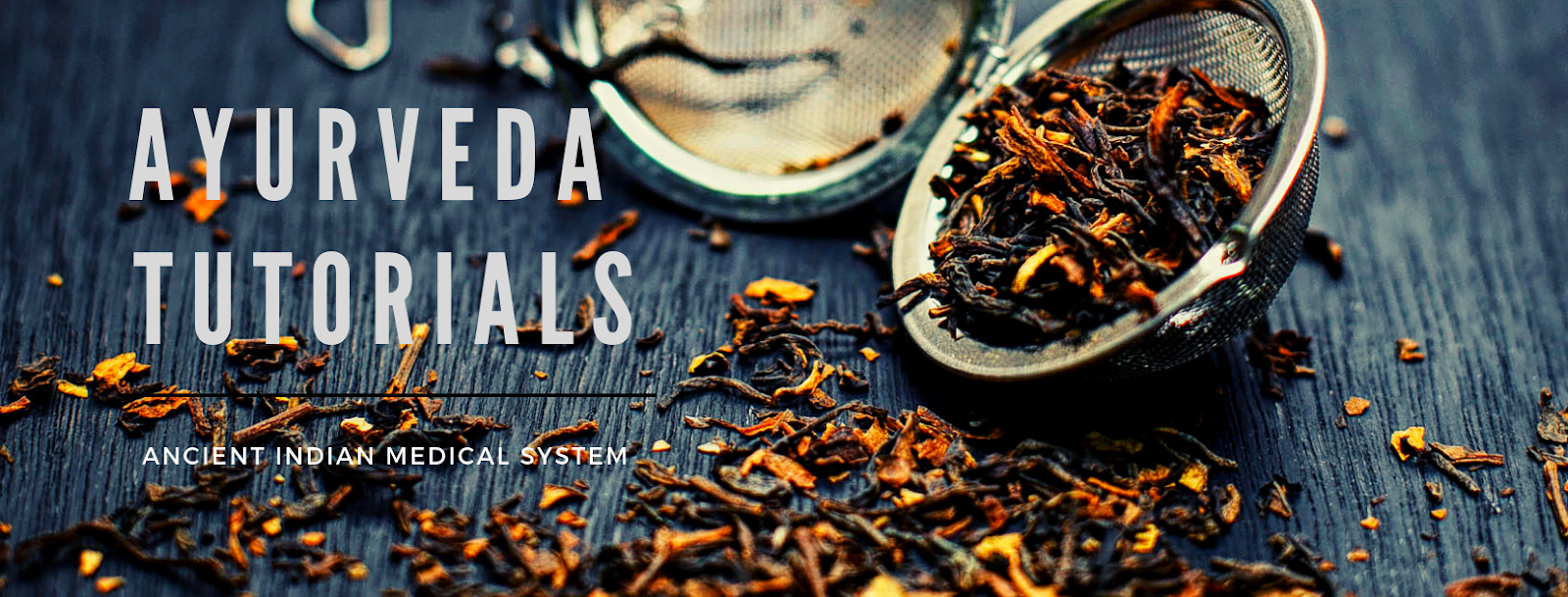
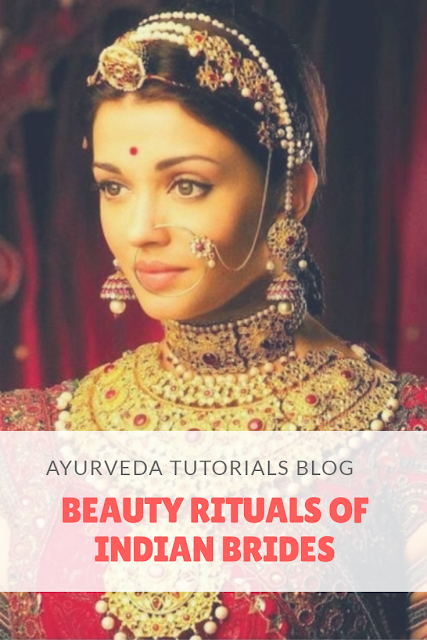

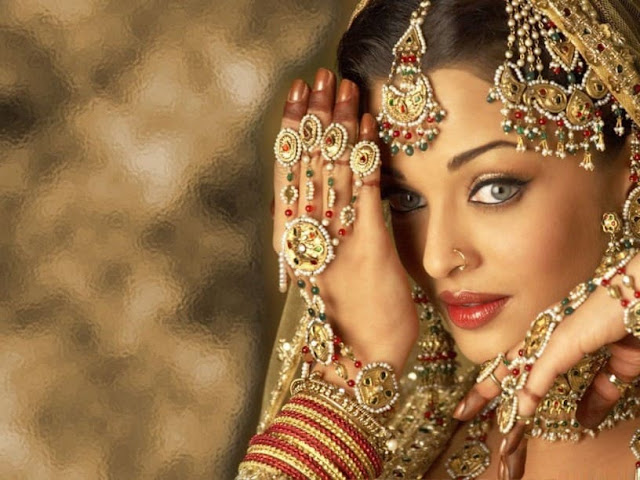
No comments:
Post a Comment